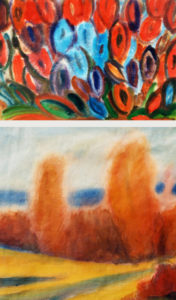Poetics of watercolor
“The color is mine. I don’t have to run after
it any longer. I know now that it nests inside
me, forever. This is the meaning of a blessed
mixture of colors. And I am a painter.”
Paul Klee
Ways of Studying Nature, 1923
![]()
The young spirits usually let themselves seduced by the sensitive “assaults” of the knowledge and feel strongly the plastic fullness and the diversity of the colorful core
greedily consumed by the fresh receptaculum of their sensitivity, as a passionate exercise of pleasure. Before the moment of sensitively feeling the nature, a young artist must learn the lesson of color exalted and emphasized by an educated observation, and only after a long experience he will become artistically fulfilled.
Without color, the surrounding world becomes a dull experience; in the absence of feelings, the geometry of spaces – with their endless insinuation, fragmentation and blur – cannot be animated. These obsessive thoughts are persistent in the artist’s mind and eye – the most precious “tool” of the artist forming the system of plastic reflection.
These empirical aspects become part of the artist’s experience which will be expressed in a rational and elaborate system becoming “una cosa mentale” – as Leonardo was calling the art!
![]()
In the 19th century the physicists developed the theory of color spectrum; the artistic currents such as the Impressionism and the Neo-impressionism emerged from there. The modern theories of the 20th century have emphasized on the chromatic synthesis as it is now perceived in the color field – beyond the excessive “idiosyncrasies” of the local environment. The most elaborate theories about color have been written by such artists as Paul Klee and Johannes Itten.
Following the didactic demands Emil Băcilă had to pursuit at “Ion Andreescu” Institute of Fine Arts in Cluj, he had to deepen the study of color and ornament, but also the painting. The field of tapestry seemed to be invaded by too many technical innovations; there was a confusion between the easel painting and the mural tapestry – as decorative element in architecture. For Emil Băcilă, the best thing to be done was to smooth the misunderstandings between the two fields and to emphasize on the plastic message.
![]()
The artist found here a favorable climate for his artistic progress in the field of traditional tapestry, rejecting the innovation that transformed the tapestry in a spatial object animated by the modern aesthetics which were promoting the “mystery”, the “grotesque“ or the “tragic”. Specific for the tapestry were the “tactility”, the “grandeur” and the “organic structure”.
The young Emil Băcilă was rather preoccupied to study the plastic message of his older colleague Paul Klee – who initiated a revolution in understanding and using the color.
![]()
When Paul Klee died on the 29th of June 1940 (for the last decade of his life he was suffering of a scleroderma), Emil Băcilă was 14 years old. Through his creation, the Master of Bauhaus made a significant contribution to the theory of color and to the study of color in art schools. “His intention was not to educate specialists or to make genius, but to teach the students a new basis of optical expression and a plastic vocabulary that each student had to verify and develop accordingly to his experience.”
![]()
In his thesis, Klee considered basic elements from mathematics and from the organic environment relevant for his plastic language. Thus, it was an opposition to the preponderance of form, as a relevant expression of death; Paul Klee preferred a vivid, dynamic formula of life itself, in a plastic expression of what he called the “genesis” of artwork.

On his courses, Klee was irradiating “an occult force upon his young students, while he was drawing with his two hands illustrating his ideas and formulating the basis of his thought and expression”. This innovation in his didactics had a remarkable echo in the European modern art contributing to the development of European avant-garde.
![]()
His innovative methods were quickly embraced by young Romanian artists who believed they were the representatives of the new European “sensibility”. In Northern Transylvania, artists had been strongly influenced by Central European art tradition and by Hungarian and Austrian national schools; they pursuit and applied the methods of Hungarian and Austrian schools as they matched with their creation, maybe in a “provincial” way, less rigorous, but keeping the basis of painting study as it was promoted by the Bauhaus School.
![]()
The professors of Fine Arts School of Cluj (1927) applied the Bauhaus School methods during its settlement in Timişoara, (1933-1945). After the war, the Hungarian Art Institute was set up in Cluj (1948); Romanian students were accepted there, too. After two years, in 1953, under the criticism of the new political power, the Institute became the “Ion Andreescu” Institute of Fine Arts, where the curriculum was organized after the Russian model of art schools.
![]()
Emil Băcilă was one of the first students graduating the Institute; he was able to accept the tough conditions of class selection imposed by the new political government.
![]()
The “Ion Andreescu” Institute of Fine Arts was an experimental appearance, the first artistic institution of the new regime of “popular power”; it had to be the “pilot institution” to prepare artists to promote the political ideologies. Through their art, those artists had to fight against the bourgeois regime – strongly represented by the artists in the traditional art centers from Bucharest and Iaşi.

